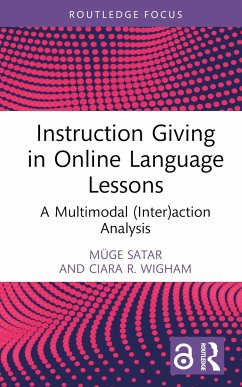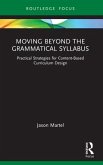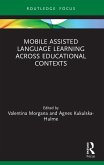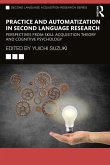Muge Satar, Ciara R. Wigham
Instruction Giving in Online Language Lessons
A Multimodal (Inter)action Analysis
Muge Satar, Ciara R. Wigham
Instruction Giving in Online Language Lessons
A Multimodal (Inter)action Analysis
- Gebundenes Buch
- Merkliste
- Auf die Merkliste
- Bewerten Bewerten
- Teilen
- Produkt teilen
- Produkterinnerung
- Produkterinnerung
This concise volume calls attention to the instruction-giving practices of language teachers in online environments, in particular videoconferencing, employing a Multimodal (Inter)action Analysis approach to explore the challenges, affordances, and pedagogical implications of teaching in these settings.
Andere Kunden interessierten sich auch für
![Moving Beyond the Grammatical Syllabus Moving Beyond the Grammatical Syllabus]() Jason Martel (USA Middlebury Institute of International Studies)Moving Beyond the Grammatical Syllabus30,99 €
Jason Martel (USA Middlebury Institute of International Studies)Moving Beyond the Grammatical Syllabus30,99 €![Language Policy and the Future of Europe Language Policy and the Future of Europe]() Alice LealLanguage Policy and the Future of Europe35,99 €
Alice LealLanguage Policy and the Future of Europe35,99 €![Mobile Assisted Language Learning Across Educational Contexts Mobile Assisted Language Learning Across Educational Contexts]() Mobile Assisted Language Learning Across Educational Contexts24,99 €
Mobile Assisted Language Learning Across Educational Contexts24,99 €![Heritage Language Program Direction Heritage Language Program Direction]() Sara M. BeaudrieHeritage Language Program Direction52,99 €
Sara M. BeaudrieHeritage Language Program Direction52,99 €![The Diagnosis of Writing in a Second or Foreign Language The Diagnosis of Writing in a Second or Foreign Language]() Ari HuhtaThe Diagnosis of Writing in a Second or Foreign Language180,99 €
Ari HuhtaThe Diagnosis of Writing in a Second or Foreign Language180,99 €![Practice and Automatization in Second Language Research Practice and Automatization in Second Language Research]() Practice and Automatization in Second Language Research62,99 €
Practice and Automatization in Second Language Research62,99 €![Exploring Identity Across Language and Culture Exploring Identity Across Language and Culture]() Alex PanicacciExploring Identity Across Language and Culture59,99 €
Alex PanicacciExploring Identity Across Language and Culture59,99 €-
-
-
This concise volume calls attention to the instruction-giving practices of language teachers in online environments, in particular videoconferencing, employing a Multimodal (Inter)action Analysis approach to explore the challenges, affordances, and pedagogical implications of teaching in these settings.
Produktdetails
- Produktdetails
- Routledge Focus on Applied Linguistics
- Verlag: Taylor & Francis Ltd
- Seitenzahl: 196
- Erscheinungstermin: 20. April 2023
- Englisch
- Abmessung: 222mm x 145mm x 14mm
- Gewicht: 394g
- ISBN-13: 9781032227948
- ISBN-10: 103222794X
- Artikelnr.: 67400356
- Herstellerkennzeichnung
- Libri GmbH
- Europaallee 1
- 36244 Bad Hersfeld
- gpsr@libri.de
- Routledge Focus on Applied Linguistics
- Verlag: Taylor & Francis Ltd
- Seitenzahl: 196
- Erscheinungstermin: 20. April 2023
- Englisch
- Abmessung: 222mm x 145mm x 14mm
- Gewicht: 394g
- ISBN-13: 9781032227948
- ISBN-10: 103222794X
- Artikelnr.: 67400356
- Herstellerkennzeichnung
- Libri GmbH
- Europaallee 1
- 36244 Bad Hersfeld
- gpsr@libri.de
Mü ge Satar is Reader in Applied Linguistics at Newcastle University, UK. She is interested in communicative and pedagogical aspects of multimodal interaction for online language learning and teaching, focusing on social presence and meaning-making. She is the co-editor of the Journal of Virtual Exchange and General Council member of UNICollaboration. Ciara R. Wigham is Senior Lecturer in English Language Teaching at Université Clermont Auvergne . Her research interests include multimodal pedagogical communication in online language learning, teacher education in computer-assisted language learning, and methodologies for multimodal CMC corpora. She is a member of the the Activité, Connaissance, Transmission, éducation research laboratory.
Preface and introduction
Chapter 1 Online language teaching and giving task instructions
1.1 Online language teaching as a semio-pedagogical activity
1.2 What are instructions and why are they important in task-based
multimodal online language teaching?
1.3 Previous studies that set the ground work
1.4 Research gap
1.5 Chapter summary
Chapter 2 Methods
2.1 Context
2.2 Methodological framework
2.3 Chapter summary
Chapter 3 Task repetition: Do teachers' instructions change when they
repeat the same lesson with different learners?
3.1 Task repetition: Higher-level actions in task instructions-as-process
3.2 Task repetition: Lower-level actions in task instructions-as-process
3.3 Modal configuration and modal density
3.4 Semiotic misalignment and modal density misalignment
3.5 Chapter summary
Chapter 4 Number of learners: Do teachers' instructions change when they
repeat the same lesson with only one learner?
4.1 Number of learners: Site of engagement
4.2 Number of learners: Higher-level actions in task
instructions-as-process
4.3 Number of learners: Lower-level actions in task instructions-as-process
4.4 Modal configuration and modal density misalignment: managing resources
4.5 Chapter summary
Chapter 5 Task type: Do teachers' instructions change when they give
instructions for a different type of task?
5.1 Divergent task micro-tasks: Task-as-workplan versus Task-as-process
5.2 Teacher perspectives on the impact of task type on their
instruction-giving behaviour
5.3 Comparison of higher-level actions used in convergent and divergent
tasks
5.4 Multimodal configuration of higher-level actions and lower-level
actions in different task types
5.5 New higher-level actions observed in the divergent task for managing
resources
5.6 Chapter summary
Chapter 6 Contributions, pedagogical reflections, and future perspectives
6.1 Contributions to methodology and knowledge
6.2 Instruction giving and task repetition
6.3 Instruction giving and number of learners
6.4 Instruction giving and task type
6.5 A heuristic framework of higher-level actions in task
instructions-as-process
6.6 Pedagogical reflections for language teachers
6.7 Limitations and future research
6.8 Final thoughts
Appendices
Chapter 1 Online language teaching and giving task instructions
1.1 Online language teaching as a semio-pedagogical activity
1.2 What are instructions and why are they important in task-based
multimodal online language teaching?
1.3 Previous studies that set the ground work
1.4 Research gap
1.5 Chapter summary
Chapter 2 Methods
2.1 Context
2.2 Methodological framework
2.3 Chapter summary
Chapter 3 Task repetition: Do teachers' instructions change when they
repeat the same lesson with different learners?
3.1 Task repetition: Higher-level actions in task instructions-as-process
3.2 Task repetition: Lower-level actions in task instructions-as-process
3.3 Modal configuration and modal density
3.4 Semiotic misalignment and modal density misalignment
3.5 Chapter summary
Chapter 4 Number of learners: Do teachers' instructions change when they
repeat the same lesson with only one learner?
4.1 Number of learners: Site of engagement
4.2 Number of learners: Higher-level actions in task
instructions-as-process
4.3 Number of learners: Lower-level actions in task instructions-as-process
4.4 Modal configuration and modal density misalignment: managing resources
4.5 Chapter summary
Chapter 5 Task type: Do teachers' instructions change when they give
instructions for a different type of task?
5.1 Divergent task micro-tasks: Task-as-workplan versus Task-as-process
5.2 Teacher perspectives on the impact of task type on their
instruction-giving behaviour
5.3 Comparison of higher-level actions used in convergent and divergent
tasks
5.4 Multimodal configuration of higher-level actions and lower-level
actions in different task types
5.5 New higher-level actions observed in the divergent task for managing
resources
5.6 Chapter summary
Chapter 6 Contributions, pedagogical reflections, and future perspectives
6.1 Contributions to methodology and knowledge
6.2 Instruction giving and task repetition
6.3 Instruction giving and number of learners
6.4 Instruction giving and task type
6.5 A heuristic framework of higher-level actions in task
instructions-as-process
6.6 Pedagogical reflections for language teachers
6.7 Limitations and future research
6.8 Final thoughts
Appendices
Preface and introduction
Chapter 1 Online language teaching and giving task instructions
1.1 Online language teaching as a semio-pedagogical activity
1.2 What are instructions and why are they important in task-based
multimodal online language teaching?
1.3 Previous studies that set the ground work
1.4 Research gap
1.5 Chapter summary
Chapter 2 Methods
2.1 Context
2.2 Methodological framework
2.3 Chapter summary
Chapter 3 Task repetition: Do teachers' instructions change when they
repeat the same lesson with different learners?
3.1 Task repetition: Higher-level actions in task instructions-as-process
3.2 Task repetition: Lower-level actions in task instructions-as-process
3.3 Modal configuration and modal density
3.4 Semiotic misalignment and modal density misalignment
3.5 Chapter summary
Chapter 4 Number of learners: Do teachers' instructions change when they
repeat the same lesson with only one learner?
4.1 Number of learners: Site of engagement
4.2 Number of learners: Higher-level actions in task
instructions-as-process
4.3 Number of learners: Lower-level actions in task instructions-as-process
4.4 Modal configuration and modal density misalignment: managing resources
4.5 Chapter summary
Chapter 5 Task type: Do teachers' instructions change when they give
instructions for a different type of task?
5.1 Divergent task micro-tasks: Task-as-workplan versus Task-as-process
5.2 Teacher perspectives on the impact of task type on their
instruction-giving behaviour
5.3 Comparison of higher-level actions used in convergent and divergent
tasks
5.4 Multimodal configuration of higher-level actions and lower-level
actions in different task types
5.5 New higher-level actions observed in the divergent task for managing
resources
5.6 Chapter summary
Chapter 6 Contributions, pedagogical reflections, and future perspectives
6.1 Contributions to methodology and knowledge
6.2 Instruction giving and task repetition
6.3 Instruction giving and number of learners
6.4 Instruction giving and task type
6.5 A heuristic framework of higher-level actions in task
instructions-as-process
6.6 Pedagogical reflections for language teachers
6.7 Limitations and future research
6.8 Final thoughts
Appendices
Chapter 1 Online language teaching and giving task instructions
1.1 Online language teaching as a semio-pedagogical activity
1.2 What are instructions and why are they important in task-based
multimodal online language teaching?
1.3 Previous studies that set the ground work
1.4 Research gap
1.5 Chapter summary
Chapter 2 Methods
2.1 Context
2.2 Methodological framework
2.3 Chapter summary
Chapter 3 Task repetition: Do teachers' instructions change when they
repeat the same lesson with different learners?
3.1 Task repetition: Higher-level actions in task instructions-as-process
3.2 Task repetition: Lower-level actions in task instructions-as-process
3.3 Modal configuration and modal density
3.4 Semiotic misalignment and modal density misalignment
3.5 Chapter summary
Chapter 4 Number of learners: Do teachers' instructions change when they
repeat the same lesson with only one learner?
4.1 Number of learners: Site of engagement
4.2 Number of learners: Higher-level actions in task
instructions-as-process
4.3 Number of learners: Lower-level actions in task instructions-as-process
4.4 Modal configuration and modal density misalignment: managing resources
4.5 Chapter summary
Chapter 5 Task type: Do teachers' instructions change when they give
instructions for a different type of task?
5.1 Divergent task micro-tasks: Task-as-workplan versus Task-as-process
5.2 Teacher perspectives on the impact of task type on their
instruction-giving behaviour
5.3 Comparison of higher-level actions used in convergent and divergent
tasks
5.4 Multimodal configuration of higher-level actions and lower-level
actions in different task types
5.5 New higher-level actions observed in the divergent task for managing
resources
5.6 Chapter summary
Chapter 6 Contributions, pedagogical reflections, and future perspectives
6.1 Contributions to methodology and knowledge
6.2 Instruction giving and task repetition
6.3 Instruction giving and number of learners
6.4 Instruction giving and task type
6.5 A heuristic framework of higher-level actions in task
instructions-as-process
6.6 Pedagogical reflections for language teachers
6.7 Limitations and future research
6.8 Final thoughts
Appendices








